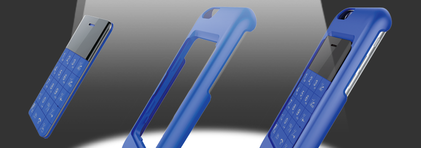The day the mobile phone took a wrong, dumb turn
A long time ago, we had really smart mobile phones:
devices compatible with any pocket, that wouldn’t distract us every second, but get enough signal even inside a cave, last one week without recharging, and years without breaking.

Then we got dumb phones that do all the opposite. Some months ago a Kickstarter project tried to fix this sorry situation, by letting us recycle the dumb, bigger phones as protecting coasters for the really smart ones. That project is having some issues, but it doesn’t matter. The mere fact to see a real mobile phone, just “reloaded” in current technology, proposed as a “must-have accessory for a mobile lifestyle”, makes me think that we really let mobile phones took a wrong, dumb turn years ago. Imagine how things could be today, if we had:
- demanded that (as in “buy only…") mobile phones do become every year smaller, lighter and with longer battery life, but remaining just mobile phones AND modems/WiFi hotspots
- bought tablets of whatever screen size and form factor, that are only capable to run apps and go online via WiFi to one’s mobile phone
- or, in other words: what if we had done with mobile computers the same thing we’ve done with _desktop /laptop ones? _What if we had kept also _mobile _hardware and software of the “applications” and “connectivity” parts physically separated, that is almost 100% interoperable no matter what brand of modem and PC you buy..
Had we done this, today we would have much more competition and real innovation in mobile computing, as well as much less planned obsolescenze, e-waste and lock-in, than the current “smart” phones give, or could ever give.
Buying a mobile computer, aka “smart” phone, bound to a phone contract is as dumb as buying a laptop or desktop computer bound to a phone contract.
Personally, I can’t wait to go “back” to the physical separation of phone/modem and computer, that would be real progress. It would be even much simpler than modular smartphones, which have serious limitations, _exactly _because they try to remain one single extra-compact object.
PS: don’t tell me you wouldn’t carry more than one device in your pockets or bag. You’re already carrying extra battery chargers, which in part are needed exactly because your current smartphone is one big power-sucking beast.
PPS: yes, some form of Instant Messaging app (but a real one, i.e. non proprietary, cross-platform Instant Messaging a-la-XMPP, not locked-to-one-phone-number crap like WhatsApp or Telegram) should be embedded in the “phone” object. But nothing else.
PPPS: I don’t really care if the physical separation happens by giving the phone/modem part the “smart” watch packaging that is so fashionable these days. As long as it is a true separation, meaning that that “watch” can work alone as a phone/modem and nothing else, and it can thus connect any separate “tablet” to the Internet
Who writes this, why, and how to help
I am Marco Fioretti, tech writer and aspiring polymath doing human-digital research and popularization.
I do it because YOUR civil rights and the quality of YOUR life depend every year more on how software is used AROUND you.
To this end, I have already shared more than a million words on this blog, without any paywall or user tracking, and am sharing the next million through a newsletter, also without any paywall.
The more direct support I get, the more I can continue to inform for free parents, teachers, decision makers, and everybody else who should know more stuff like this. You can support me with paid subscriptions to my newsletter, donations via PayPal (mfioretti@nexaima.net) or LiberaPay, or in any of the other ways listed here.THANKS for your support!